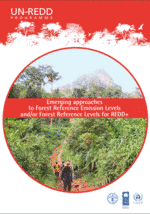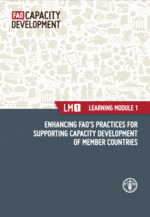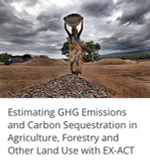Tools
A tool is a resource that supports and guides the implementation of SFM. This section includes all the tools available in the SFM Toolbox, which can be in form of publications, e-learning videos, software etc.
You can browse the Tools through keywords in the free search box or you can narrow the search using the filters on the right side of the page.
The purpose of this document is to provide examples of emerging approaches to FREL/FRL development adopted in different contexts, including for demonstration activities by countries seeking to take actions to reduce GHG emissions or enhance forest carbon stocks in the forest sector. The document shows that a range of different...
This is an article on the International Women’s Day event at FAO eyes role of gender equality in ending hunger and fostering sustainable food systems.
The webpage hosting the article has also links to a photo gallery and to the the audio of the of International Women's Day event at FAO...
The purpose of this learning module is to provide FAO staff and consultants at all levels with a basic understanding and knowledge of Capacity Development (CD), reflecting the international debate as well as FAO’s perspective on CD. It also provides some key
concepts for adopting changes in responsibilities, behaviours and attitudes...
Non-Wood Forest Products (NWFPs) play an important role for Lao people’s daily
livelihoods, especially in rural areas. They are used for food, medicines, provide a
source of income and have many other uses. NWFPs are estimated to make up over
40 percent of total rural income in Lao PDR, and they play a...
This publication explains the rationale for enhancing stakeholder participation in nfp processes, describes skills, and instructs on methods for enhancing stakeholder participation in nfps. Stakeholder Participation is practically demonstrated throughout the nfp phases of analysis; policy formulation and planning; implementation; and monitoring and evaluation (M&E)1. None of these methods and...
National forest programmes (nfps) have become a commonly agreed framework for planning and implementation of forestry activities in pursuit of sustainable forest management at the country level. FAO and the National Forest Programme Facility, are jointly working to build country capacity for implementation of nfps, in accordance with the nfp...
This Agroforestry in Action guide is intended to help design and manage the interactive agroforestry practice of Riparian Forest Buffers. Properly applied on a landscape, the riparian forest buffer can enhance and diversify farm income opportunities, improve the environment and create wildlife habitat. By developing an understanding of the interactions...
Richard Hauer, associate professor of forestry, University of Wisconsin Stevens-Point illiustrates how to establish climatic adaptive trees in urban landscapes at 2014 Urban Tree Conference.
Are you aware that AFOLU contributes to carbon sequestration as co-benefits through productive and sustainable landscape management? At the same time, Agriculture, Forestry and Land Use Change (AFOLU) is the second largest emitter of greenhouse gas (GHG) emissions worldwide. GHG accounting in the AFOLU sector is an important indicator and...
Climate change is one of the truly global issues of our time, and forests play an important role in it. Changes in the cover, use, and management of forests produce sources and sinks of carbon dioxide which are exchanged with the biosphere. Estimation of the magnitude of these sources and...










